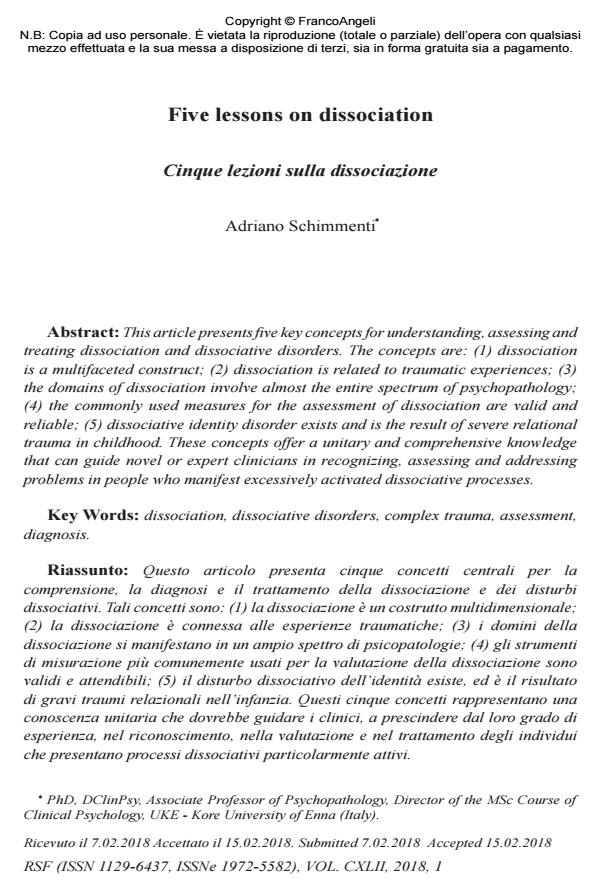Five lessons on dissociation
Titolo Rivista RIVISTA SPERIMENTALE DI FRENIATRIA
Autori/Curatori Adriano Schimmenti
Anno di pubblicazione 2018 Fascicolo 2018/1
Lingua Inglese Numero pagine 19 P. 73-91 Dimensione file 1750 KB
DOI 10.3280/RSF2018-001005
Il DOI è il codice a barre della proprietà intellettuale: per saperne di più
clicca qui
Qui sotto puoi vedere in anteprima la prima pagina di questo articolo.
Se questo articolo ti interessa, lo puoi acquistare (e scaricare in formato pdf) seguendo le facili indicazioni per acquistare il download credit. Acquista Download Credits per scaricare questo Articolo in formato PDF

FrancoAngeli è membro della Publishers International Linking Association, Inc (PILA)associazione indipendente e non profit per facilitare (attraverso i servizi tecnologici implementati da CrossRef.org) l’accesso degli studiosi ai contenuti digitali nelle pubblicazioni professionali e scientifiche
This article presents five key concepts for understanding, assessing and treating dissociation and dissociative disorders. The concepts are: (1) dissociation is a multifaceted construct; (2) dissociation is related to traumatic experiences; (3) the domains of dissociation involve almost the entire spectrum of psychopathology; (4) the commonly used measures for the assessment of dissociation are valid and reliable; (5) dissociative identity disorder exists and is the result of severe relational trauma in childhood. These concepts offer a unitary and comprehensive knowledge that can guide novel or expert clinicians in recognizing, assessing and addressing problems in people who manifest excessively activated dissociative processes.
Questo articolo presenta cinque concetti centrali per la comprensione, la diagnosi e il trattamento della dissociazione e dei disturbi dissociativi. Tali concetti sono: (1) la dissociazione è un costrutto multidimensionale; (2) la dissociazione è connessa alle esperienze traumatiche; (3) i domini della dissociazione si manifestano in un ampio spettro di psicopatologie; (4) gli strumenti di misurazione più comunemente usati per la valutazione della dissociazione sono validi e attendibili; (5) il disturbo dissociativo dell’identità esiste, ed è il risultato di gravi traumi relazionali nell’infanzia. Questi cinque concetti rappresentano una conoscenza unitaria che dovrebbe guidare i clinici, a prescindere dal loro grado di esperienza, nel riconoscimento, nella valutazione e nel trattamento degli individui che presentano processi dissociativi particolarmente attivi.
Parole chiave:Dissociazione, disturbi dissociativi, trauma complesso, valutazione, diagnosi
Adriano Schimmenti, Five lessons on dissociation in "RIVISTA SPERIMENTALE DI FRENIATRIA" 1/2018, pp 73-91, DOI: 10.3280/RSF2018-001005